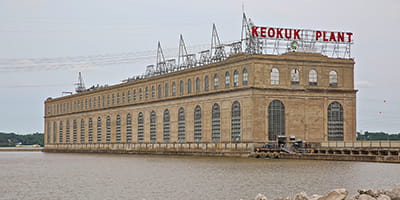Keokuk Renewable Energy Center

100 years of clean, low cost, reliable power
Since 1913, Ameren Missouri’s Keokuk Energy Center has harnessed the power of the mighty Mississippi River. The hydroelectric power plant creates clean, low cost and reliable energy, generating enough electricity annually to power 75,000 homes.
Clean Known as a “run-of-river” plant, Keokuk Energy Center uses the natural energy of falling water to generate electricity. This constant, renewable energy source doesn't produce any air emissions or solid waste, keeping our environment cleaner.
Low Cost Because the energy center uses water instead of fuel, operating costs at Keokuk Energy Center are well below those of nuclear or fossil fuel plants. For example, an average day of operation at Keokuk saves the equivalent of 1,000 tons of coal. This reduces Ameren Missouri’s overall fuel costs, helping us to keep rates low for our customers.
Reliable Additionally, because a hydro power plant can be started in minutes, unlike fossil or nuclear fuel plants, Keokuk plays a vital role in the reliability of Ameren Missouri’s power supply system. It can provide needed power in a system emergency and help meet electrical demand during “peak” periods.
How It All Began
In addition to playing an important role in the Ameren Missouri system, the Keokuk Energy Center is also an engineering marvel, known as the greatest water development project of its time, and the birthplace of inventions that forever changed the transmission of electrical power. As far back as 1836, the site in Keokuk, IA was identified as a potential source of power. A surveyor for the U.S. War Department named Robert E. Lee (who would later become the commander of the Confederate Army during the Civil War) called attention to this turbulent and steep section of the Mississippi River, known as the Des Moines Rapids. But no one was able to control it.
In 1899, a group of prominent men from Keokuk and neighboring Hamilton, IL, got together. They planned to employ the river’s power with a dam to generate electricity and attract businesses to the area. The company they created spent the next several years securing funds, conducting a feasibility study and finally getting legislation passed by the Federal Government to approve the project. The company then sought an engineering talent who could handle the massive project. Hugh L. Cooper, who had engineered construction of a hydro plant at Niagara Falls, NY, was selected. Construction financing was finally secured with the backing of contracts to supply electrical power to three customers in the St. Louis area (Union Electric Light and Power Company, Laclede Gas Company, and streetcar operator United Railways Company).
